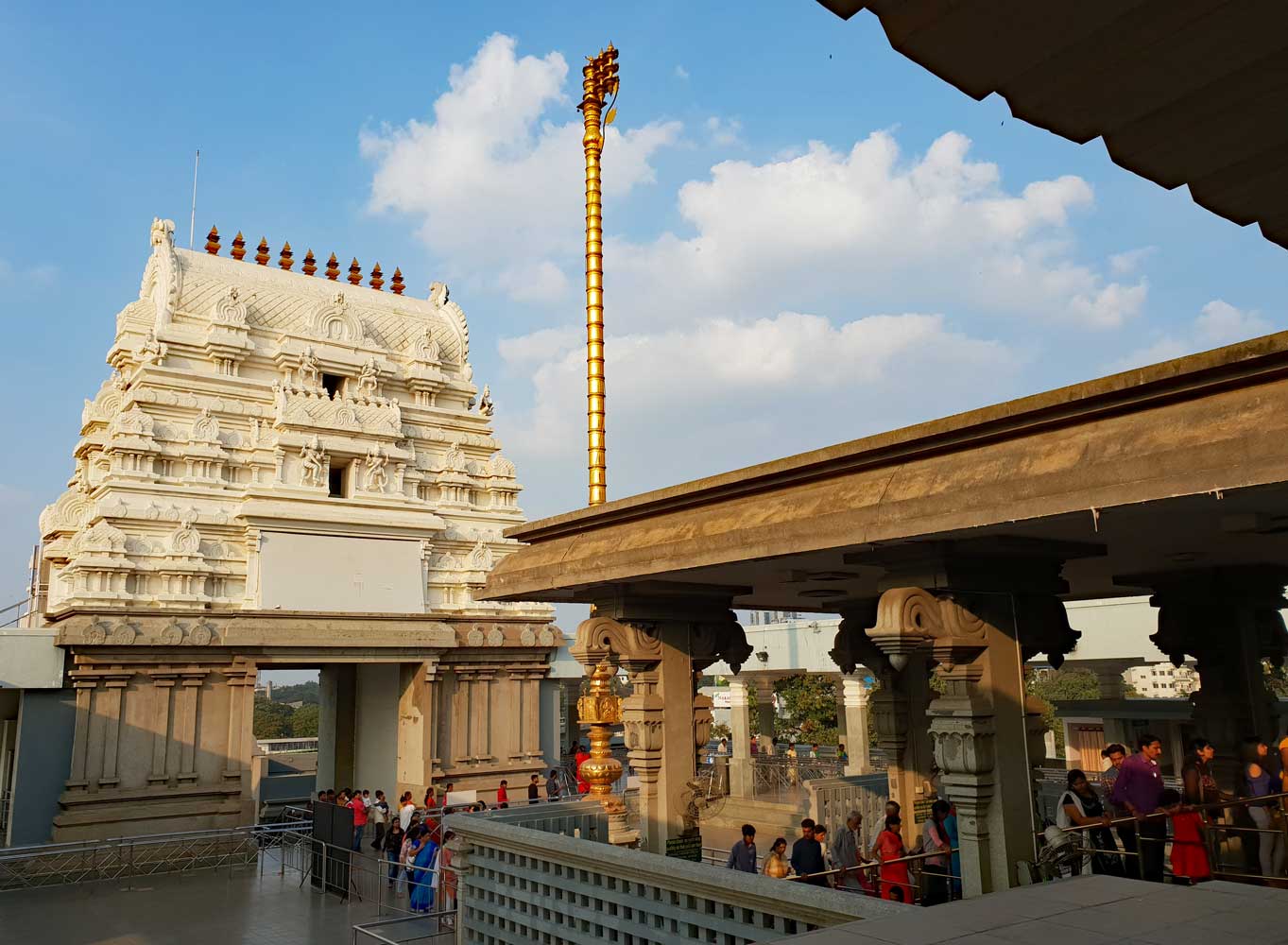
We have just entered through this gate.

The golden roof of a shrine; statues of Garuda, Vishnu’s vehicle, kneel at the four corners.
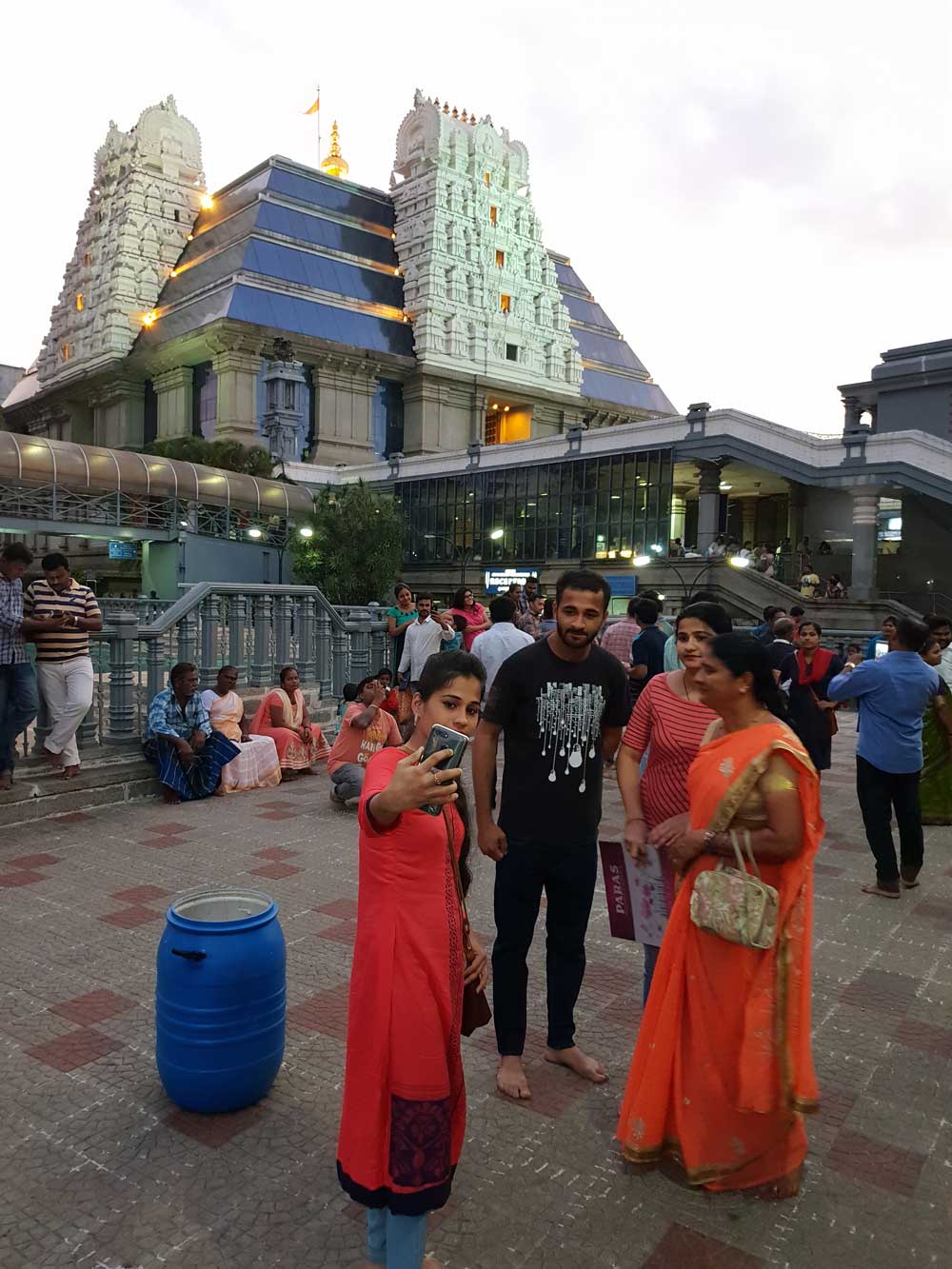
We emerge onto this courtyard after a visit to the main temple, which rises in the background.
India 22 Dec. 2018-Jan. 29, 2019
I’m off to South India for a five-week backpacking
trip, and plan to meet up with two women from Sacramento for travels together, though
I will be solo before and after their time here. I’m carrying the Lonely Planet
South India & Kerala guidebook, 9th edition (Oct. 2017) on my phone and computer.
The region is easy and cheap to visit from Thailand with Air Asia, and I flew in
to Bengaluru from Bangkok and will return on a flight from Chennai.
22 December
Bengaluru
My VIP bus from Phuket pulled into Bangkok’s huge Northern/Northeastern
Bus Terminal about an hour after sunrise. Long lines of taxis awaited customers,
but a taxi mafia prevented any of them from taking me to the nearby metro station!
Only ‘tuk-tuk’ three-wheelers and motorbike taxis would do that trip, and at an
inflated price. So I walked out of the bus terminal and quickly got a proper taxi
to the Mo Chit/Chatuchak Park metro and rode it to the Lumphini station near the
Airbnb where I had stayed on my arrival in Thailand. I had stored my bicycle and
panniers here and needed to retrieve my India visa—still valid in an expired passport—or
I wouldn’t be going anywhere tonight. The Airbnb manager let me get a shower, then
hang out in the shaded courtyard during the day. I rested and worked on my online
journal, then set off in the afternoon to the MBK shopping center to get a pair
of shower sandals, not easy for my large shoe size, and found a pricey pair. I also
visited nearby Bangkok Art & Culture Centre http://en.bacc.or.th/ for a look
at new and some old exhibits. Back at the Airbnb, I grabbed my backpack and quickly
got a Grab taxi to the old Don Muang Airport. Check-in at Air Asia took a very long
time, as did getting through immigration. Finally I got a bus out to the plane,
an Airbus A320 for flight FD 137 to Bengaluru, the capital of India’s Karnataka
state. The plane took off about 8:20 p.m. and took a little less than four hours.
Passengers on Air Asia must pay extra to check a bag, and it’s not much more to
get a hot meal and to select a window seat. Surprisingly I got two hot vegetarian
meals this time!
Bengaluru’s airport provided a pleasant welcome to India,
and I was soon on my way in a taxi for the longish ride into the city to my Airbnb,
‘Victoriya Inn – Comfy Modern Living @ Old Bangalore.’ Normally a midnight arrival
would have been inconvenient for my host, but he happened to be having a late-night
birthday celebration, and shared a luscious cake with me and his other guests. He
and his wife follow Christianity and had two Christmas trees aglow in the common
area.
23 December Bengaluru
After two nights of travels with little sleep,
I took a rest day and stayed near the Airbnb. This was my second time to this city,
but the first for sightseeing. Way back in 1983 on my first India visit, I had detoured
here to see about a visa extension and found out that I would need proper photos
to get it. In those days before instant photography, that meant going to a photo
studio, then waiting a couple days for the prints. It turned out that most large
cities could process a visa extension, and I successfully got one down the road
in Bijapur.
24 December Bengaluru
A young couple ran the Airbnb, and the
wife offered tasty food, so most mornings I would get a South Indian breakfast before
heading off sightseeing. Bengaluru sits in the center of southern India at an elevation
of 920 meters and had very pleasant weather with cool nights despite being in the
tropics. It’s not only a center for government and business, but also for Information
Technology, though the IT places are in the outer suburbs. Relatively few tourists
come here, but Bengaluru does have museums, parks, and other big-city sights. Two
art museums especially appealed, and today I headed by Uber taxi over to Karnataka
Chitrakala Parisnath www.karnatakachitrakalaparishath.com/
for its highly varied collection of traditional and modern art. The first gallery
had color studies of the Himalaya by Russian artist and mystic Nicholas Roerich
(1874-1947), whose works I had first encountered when visiting his museum and former
home in the Kullu Valley of the Himalayan foothills. Another gallery displayed paintings
by his son Svetoslav, but I didn’t find these as appealing. Hallways and several
galleries had traditional art and folk crafts of Karnataka state, which I liked.
The Krishna Reddy Gallery contained colorful and intriguing intaglio prints that
played with abstraction and geometry. Dark themes pervaded many paintings and sculptures
in the modern art galleries. Back at the Airbnb, I had a good simple Indian dinner.
25 December Bengaluru
I thought of visiting one of the churches on Christmas
Day, but instead opted for the ISKCON temple
https://www.iskconbangalore.org/
that opened in 1997 and is one of the largest Hare Krishna temples in the world.
Like many Hindu temples, it’s open mainly in the morning and evening, so I arrived
at 4:15 p.m. just as it was opening. Crowds of devotees also had arrived at this
well-organized complex. We first checked our shoes, then staff suggested that I
buy a 300-rupee (UD $4.30) special ticket that would let me bypass the lines plus
get prasadam (blessed food) and a free book. I did that, hardly feeling guilty at
all. On the long flight of steps up to the main temple I stopped at two shrines
with gold-topped roofs that honor Krishna and his clan. The main temple building
has four traditional towers set into a contemporary structure. Inside musicians
and singers performed devotional songs. The long altar had three sections devoted
to Krishna and his family with lots of flower garlands and gleaming gold. A priest
waved an oil lamp during a puja for devotees. One of the temple staff gave me two
packets of sweets (prasadam), then I headed downstairs and got a colorful children’s
book on the Ramayana story. Like any major sight, the temple has a huge souvenir
shop, mainly religious items. Sweet shops offered a huge array of cakes and traditional
Indian sugary treats along with other snacks. I stopped in the temple’s modest restaurant
for a light South Indian dinner. A three-wheeler took me back across town to my
Airbnb.

We have just
entered through this gate.

The golden roof
of a shrine; statues of Garuda, Vishnu’s vehicle, kneel at the four corners.

We emerge onto
this courtyard after a visit to the main temple, which rises in the background.
26 December Bengaluru
Under bright blue skies I caught an Uber taxi to Lalbagh
Botanical Gardens, a vast spread with big trees, small plants, a lake, and a curious
dome of bare gneiss rock,
https://horticulturedir.karnataka.gov.in/page/Gardens/Lalbagh/en.
Development began in 1760 as a private Mughal garden of Hyder Ali, one of the most
famous rulers of old Mysore, and has been greatly expanded since. I started with
the bonsai garden, then wandered among the towering trees and palms, both Indian
and exotics, on a very pleasant walk. Several old architectural gems dot the green
landscape, most notably the open-sided 1889 Glass House. Lastly I climbed the gentle
dome of gneiss, thought to be 3 billion years old and now a national geological
monument.
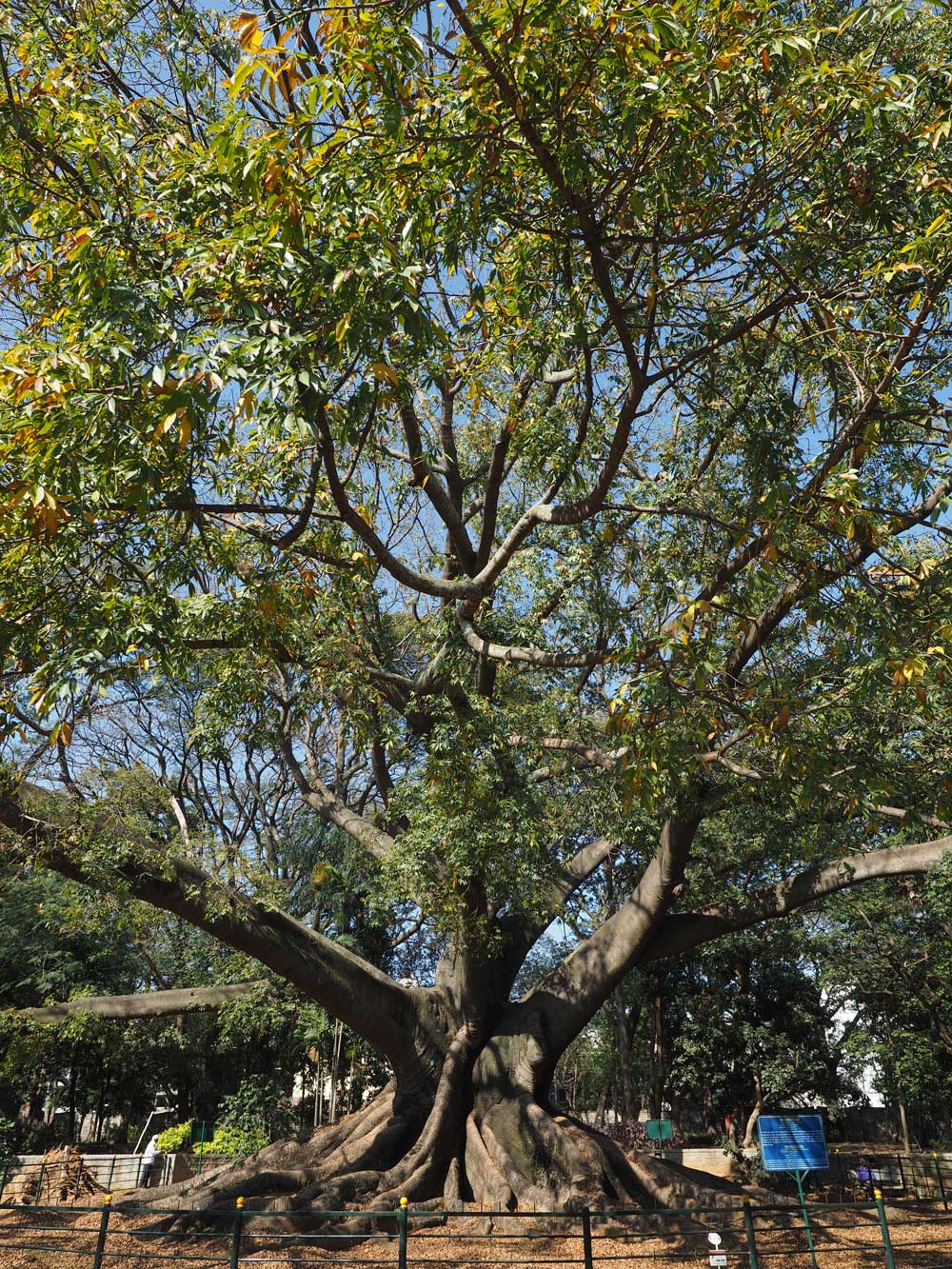
This white silk cotton tree (Ceiba pentandra) is about 200 years old
and native to India and China.
 The
Cuban royal palm or the Florida royal palm (Roystonea regia) is native
to Mexico, parts of Central America and the Caribbean, and southern Florida, and
it has been planted throughout the tropics and subtropics as an ornamental tree.
The fruit is eaten by birds and bats, which disperse the seeds, and fed to livestock.
Its flowers are visited by birds and bats, and it serves as a roosting site and
food source for a variety of animals. In Christianity, it is used in Palm Sunday
observances. (Wikipedia)
The
Cuban royal palm or the Florida royal palm (Roystonea regia) is native
to Mexico, parts of Central America and the Caribbean, and southern Florida, and
it has been planted throughout the tropics and subtropics as an ornamental tree.
The fruit is eaten by birds and bats, which disperse the seeds, and fed to livestock.
Its flowers are visited by birds and bats, and it serves as a roosting site and
food source for a variety of animals. In Christianity, it is used in Palm Sunday
observances. (Wikipedia)
 All
40 species of cormorants are fish-eaters, catching the prey by diving from the surface.
They are excellent divers, and under water they propel themselves with their feet
with help from their wings; some cormorant species have been found to dive as deep
as 45 meters. They have relatively short wings due to their need for economical
movement underwater, and consequently have the highest flight costs of any flying
bird. Cormorants nest in colonies around the shore, on trees, islets or cliffs.
They are coastal rather than oceanic birds, and some have colonised inland waters.
They range around the world, except for the central Pacific islands. (Wikipedia)
All
40 species of cormorants are fish-eaters, catching the prey by diving from the surface.
They are excellent divers, and under water they propel themselves with their feet
with help from their wings; some cormorant species have been found to dive as deep
as 45 meters. They have relatively short wings due to their need for economical
movement underwater, and consequently have the highest flight costs of any flying
bird. Cormorants nest in colonies around the shore, on trees, islets or cliffs.
They are coastal rather than oceanic birds, and some have colonised inland waters.
They range around the world, except for the central Pacific islands. (Wikipedia)
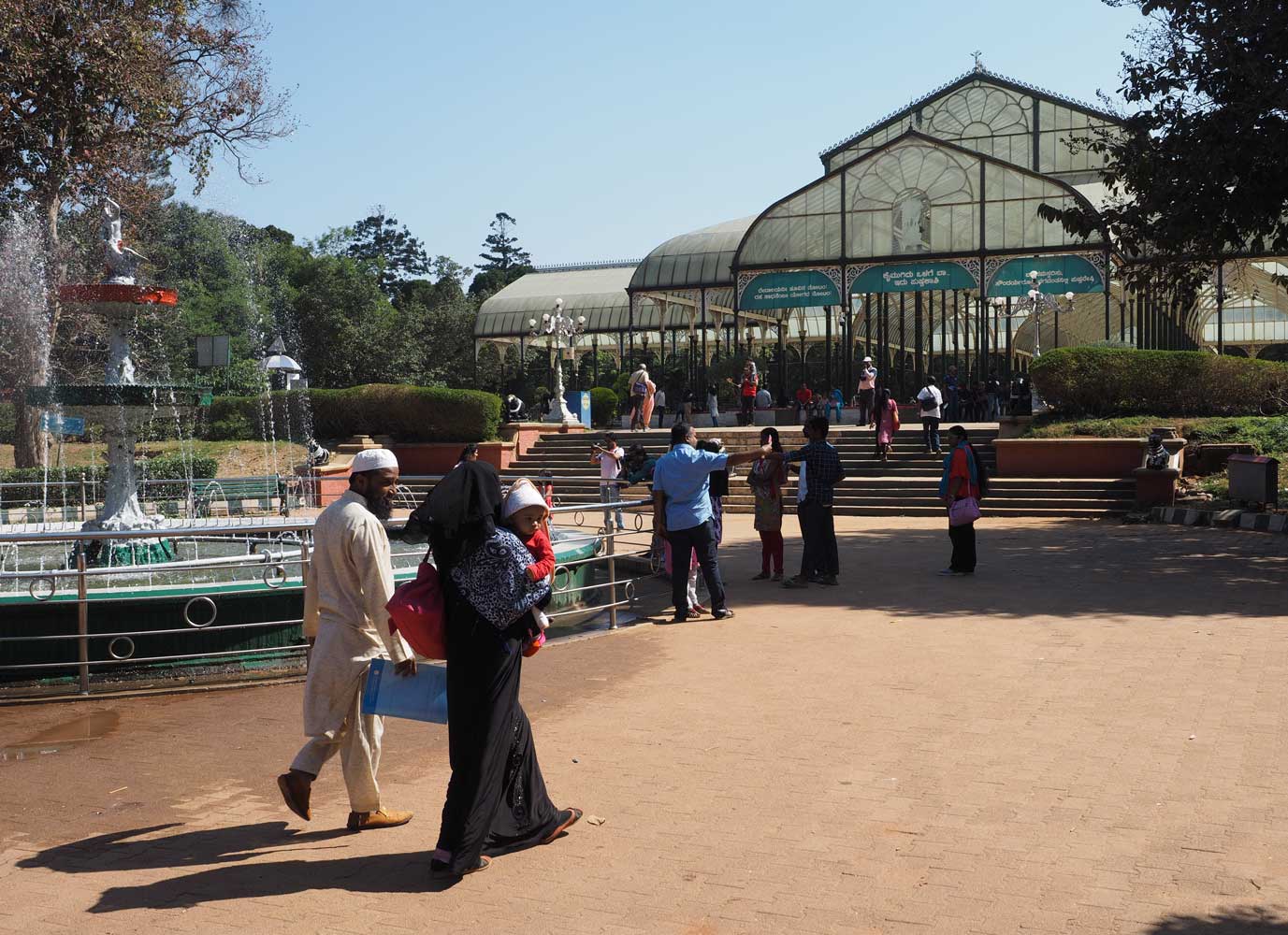
The Glass House

School girls, later
followed by a group of school boys, stroll past the Glass House, devoid of plantings
today.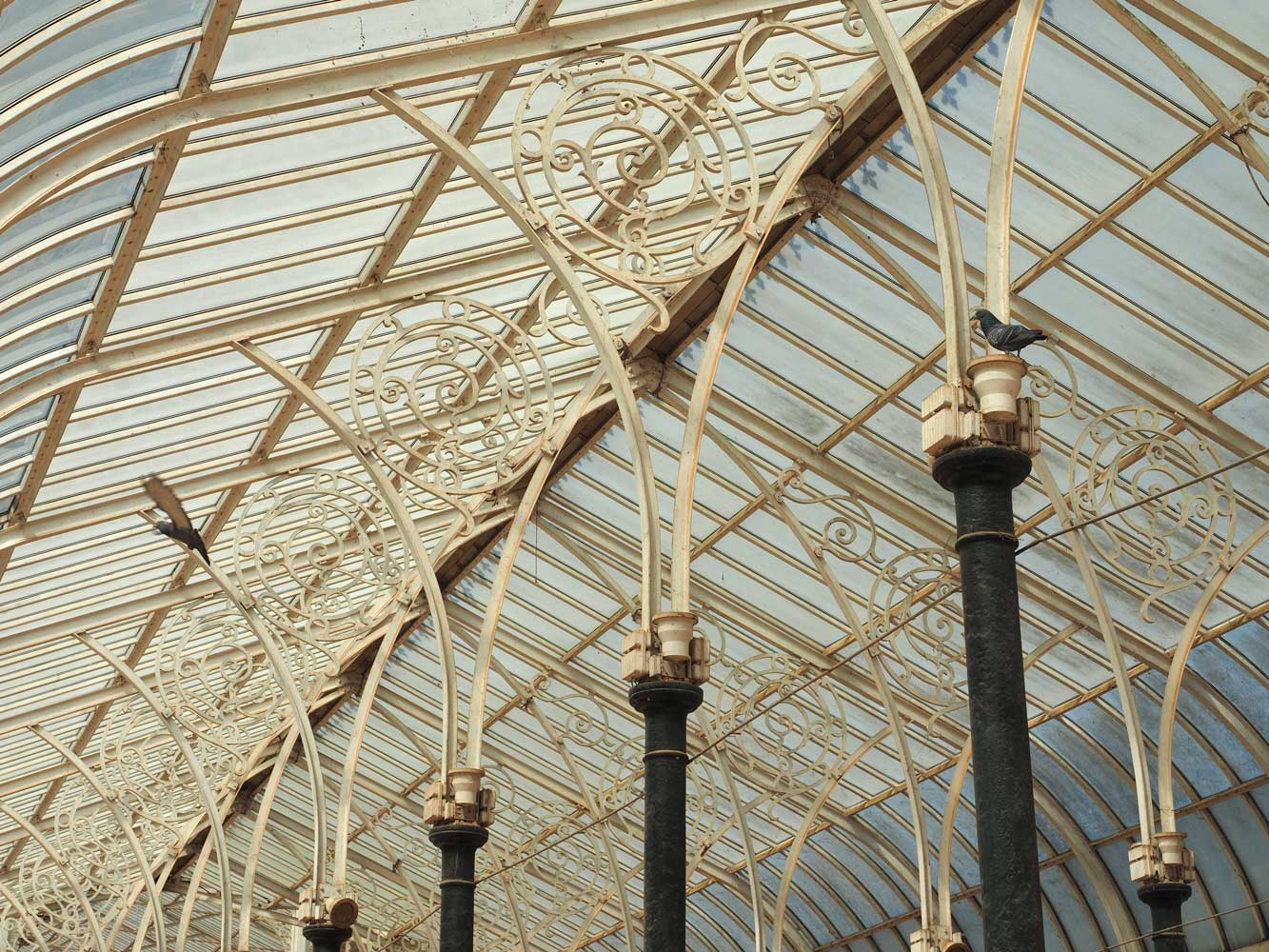
Glass House detail

A pavilion tops
this dome of gneiss.
A short ride by three-wheeler took me to the Bull Temple, a small structure dominated by an enormous stone statue of a bull, the god Shiva’s mount, 4.5 meters high and 6.5 meters long.
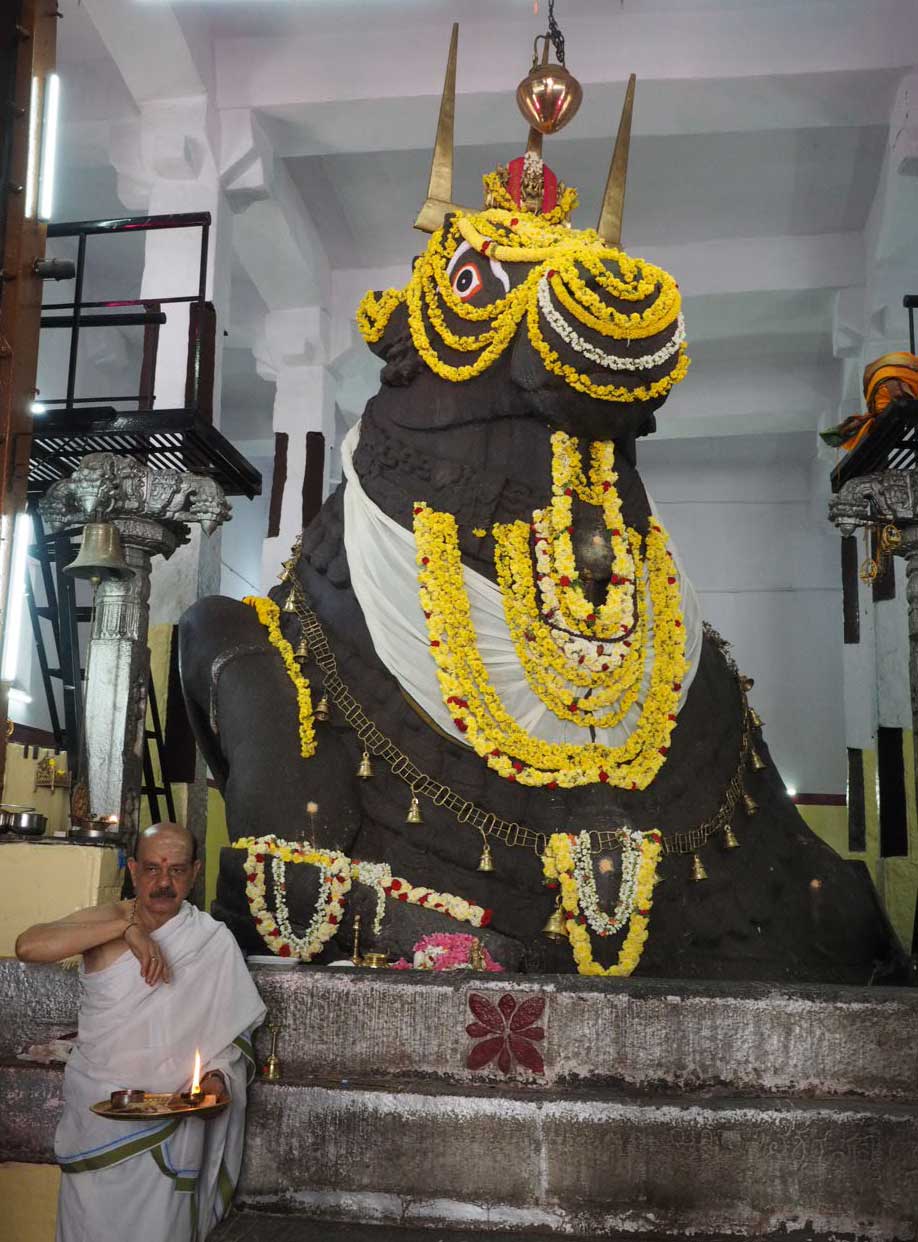
The Big Bull!
Another short ride in a three-wheeler led to Tipu Sultan’s Summer Palace, completed in 1791 and famed for its open design with teak pillars and decorative paintings. It’s a very pretty two-story Indo-Islamic building full of arches and pillars, though the paintings have faded over the centuries. The front and back have identical layouts in this highly symmetrical structure.
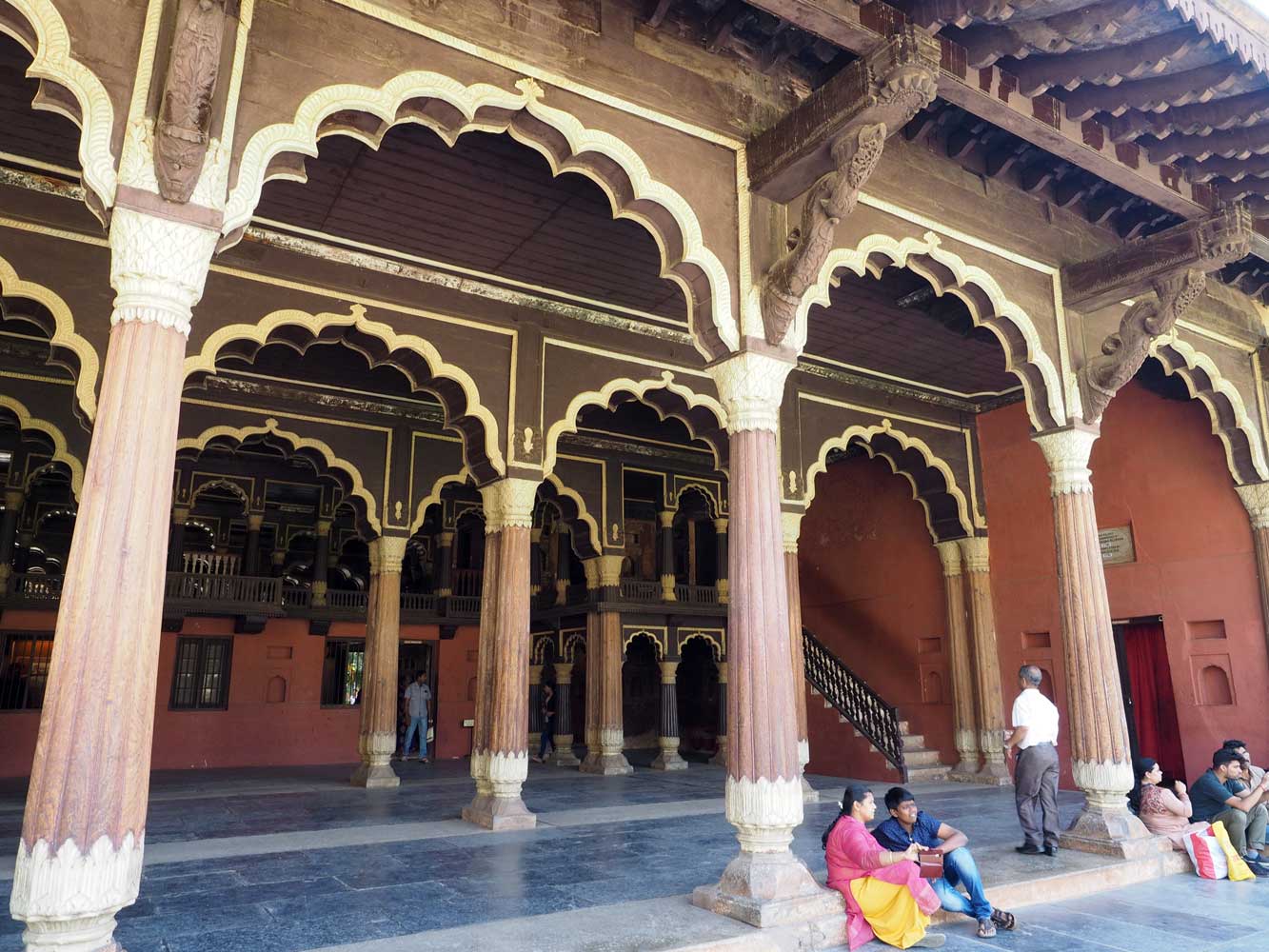
Shady recesses and
the open interior would have made this a cool retreat in summer.
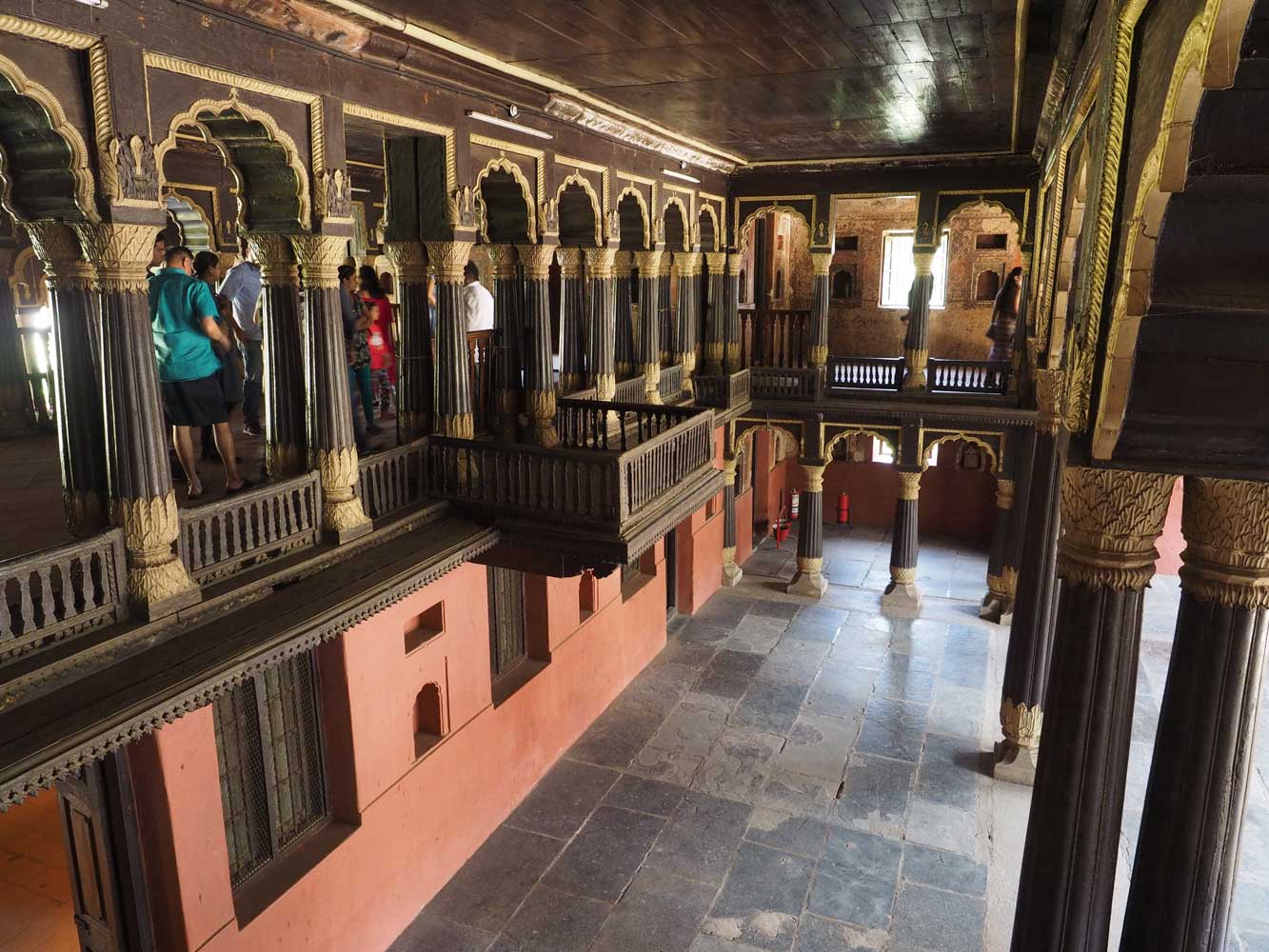
I think the sultan
would have hung out and met visitors on this upper level.
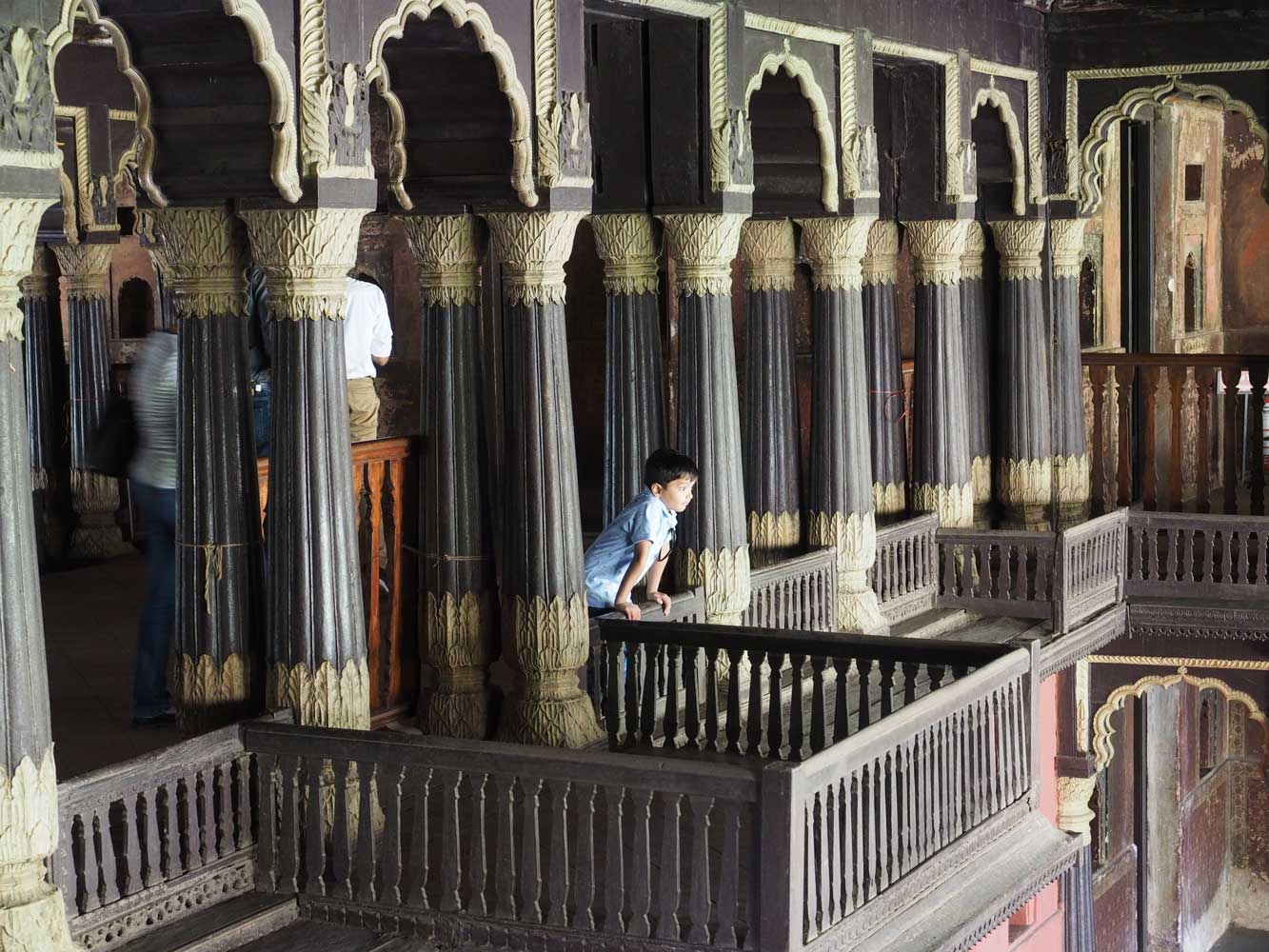
Lots of pillars!

A hint of the how
colorful the interior once was.
Originally the palace had been within the walls of Bangalore Fort, built in 1761 and destroyed by the British 30 years later. One finely built gate still remains, and I walked north to see it.

Gate detail

Inner gate
A bit farther north and across a busy road I came to the imposing brick gateway of the Krishnarajendra Market, packed with produce, spices, iron and copper ware, and lots and lots of flowers.
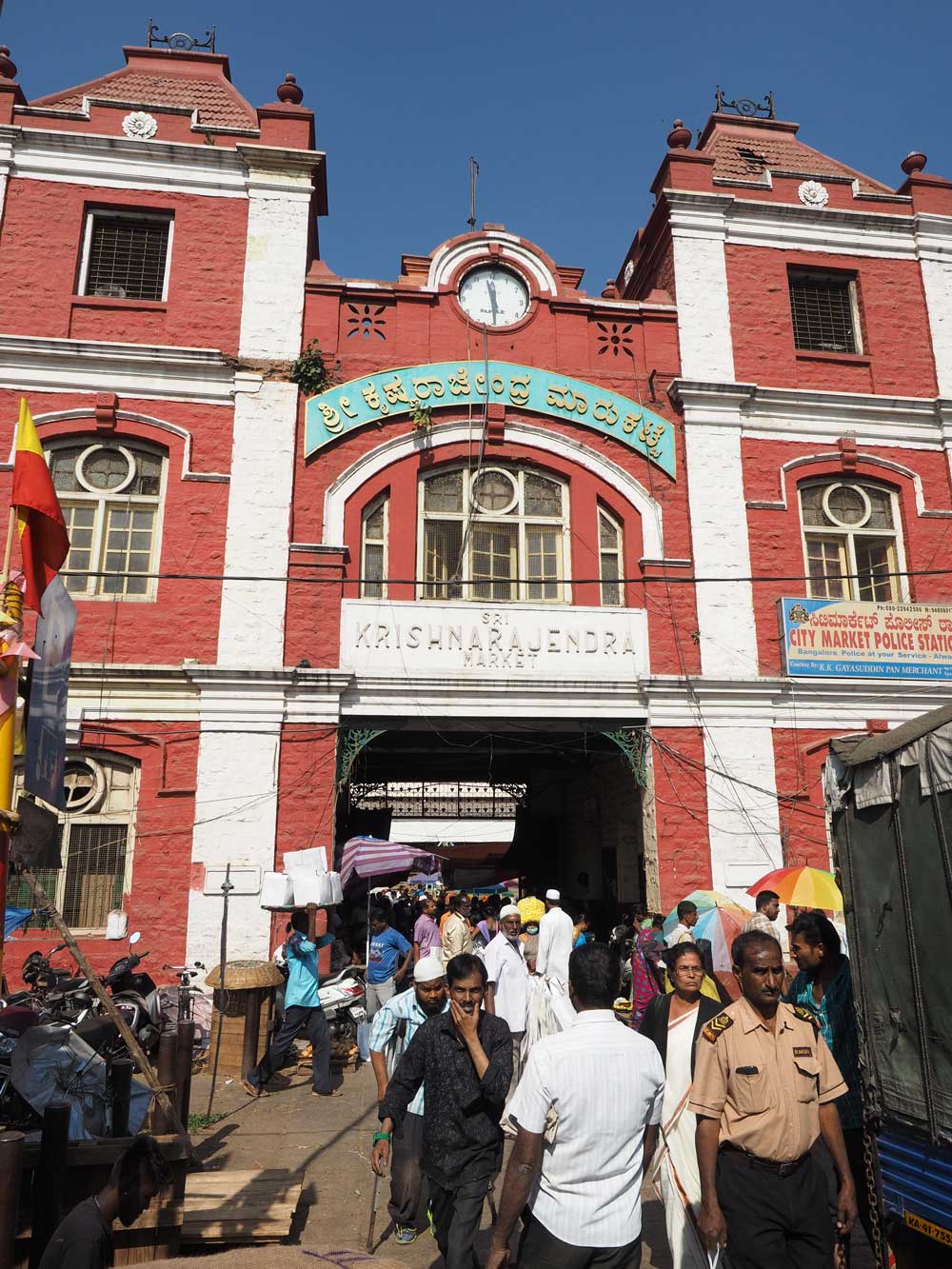
The main entrance
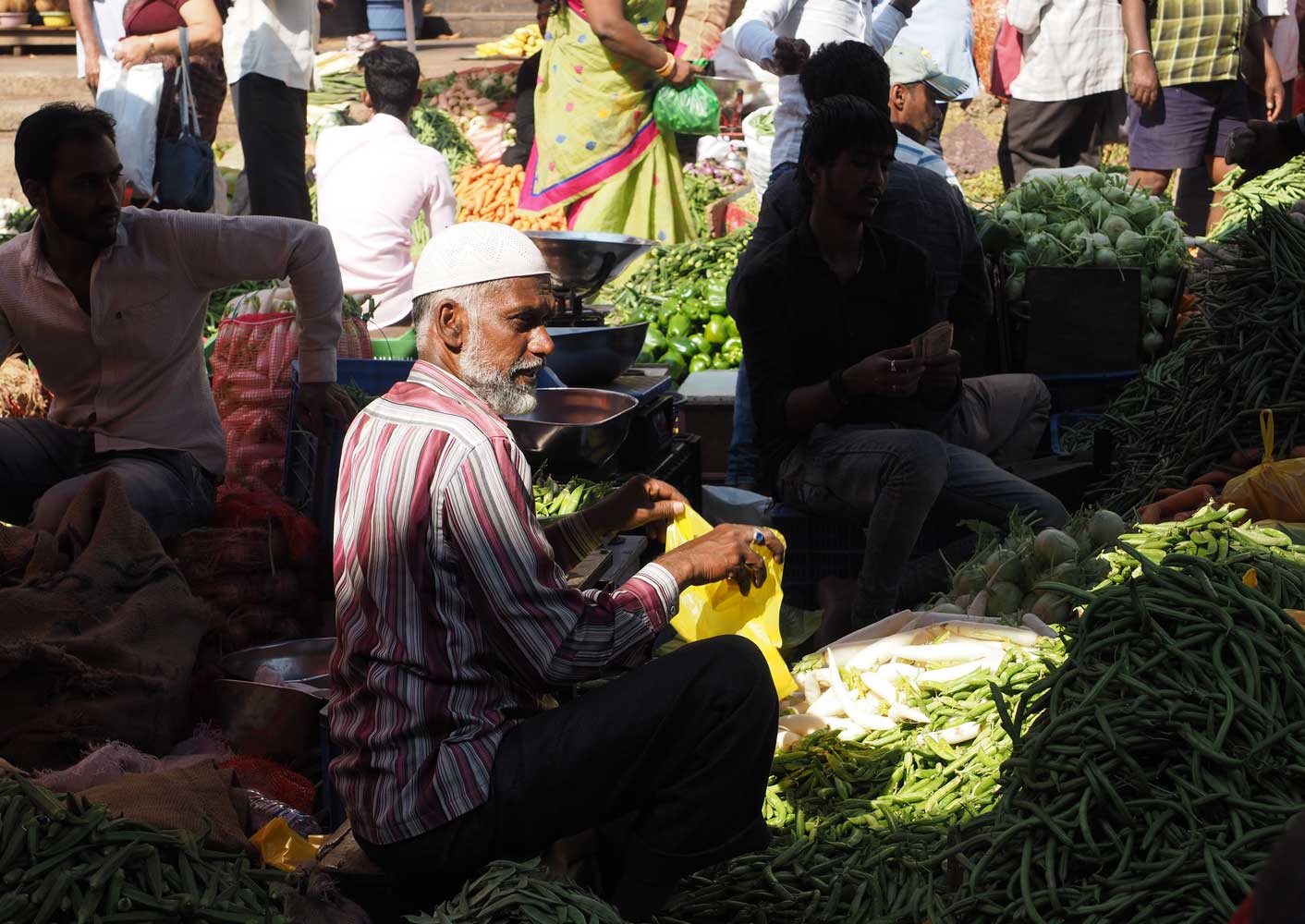
The market spills
outside.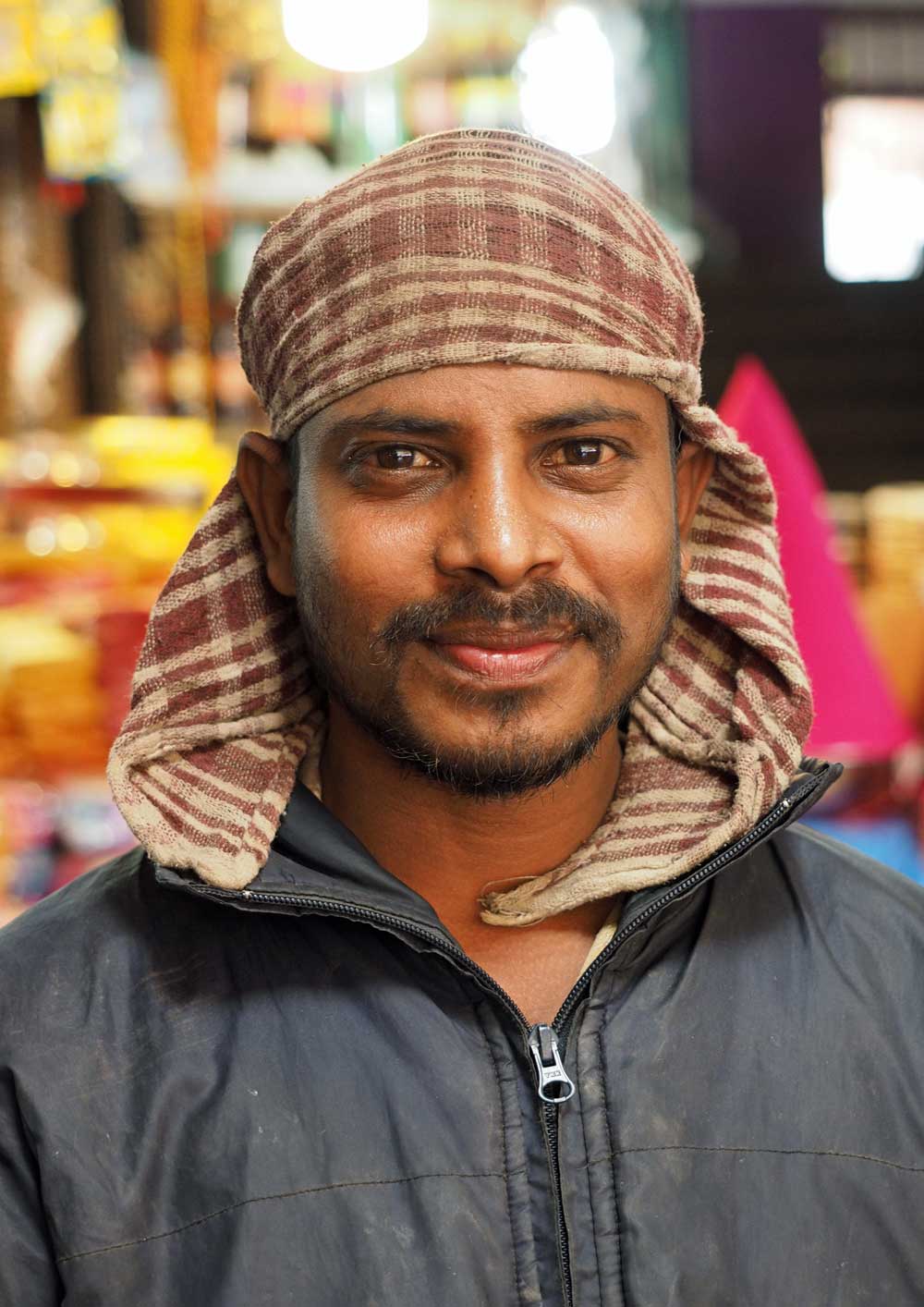
Market
man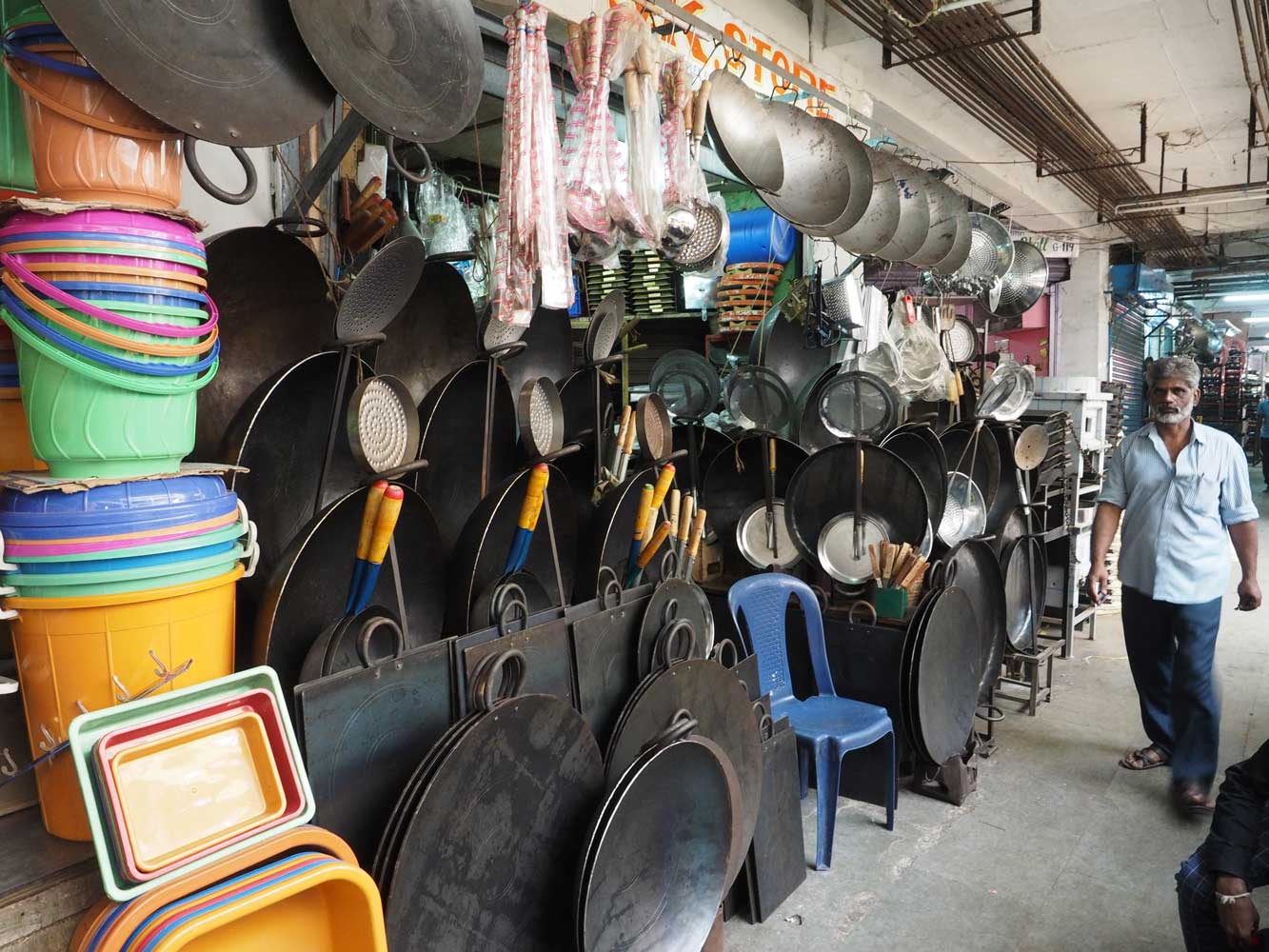
All you
need for your kitchen!

Flowers take center
stage.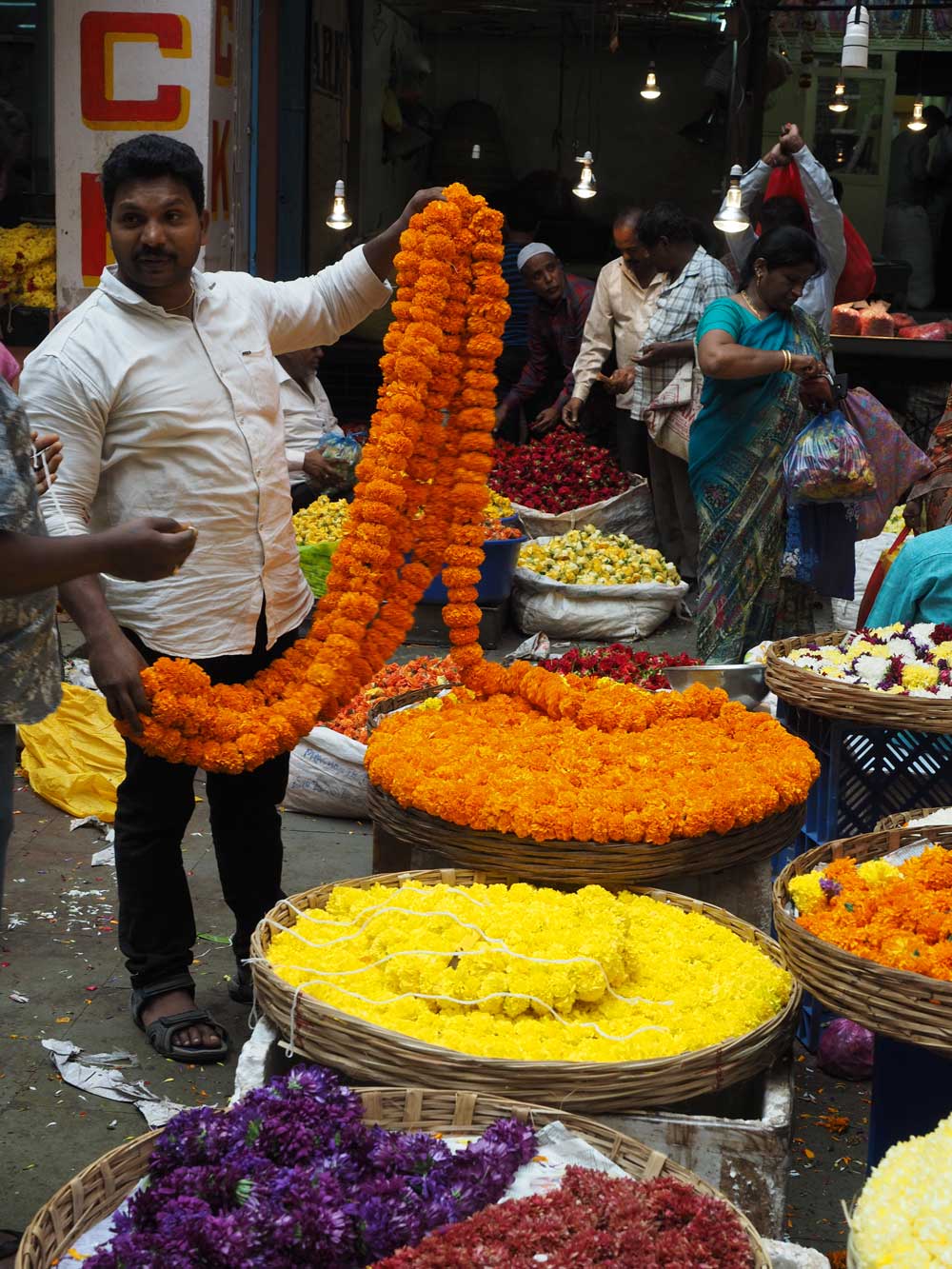
Indians
love marigolds!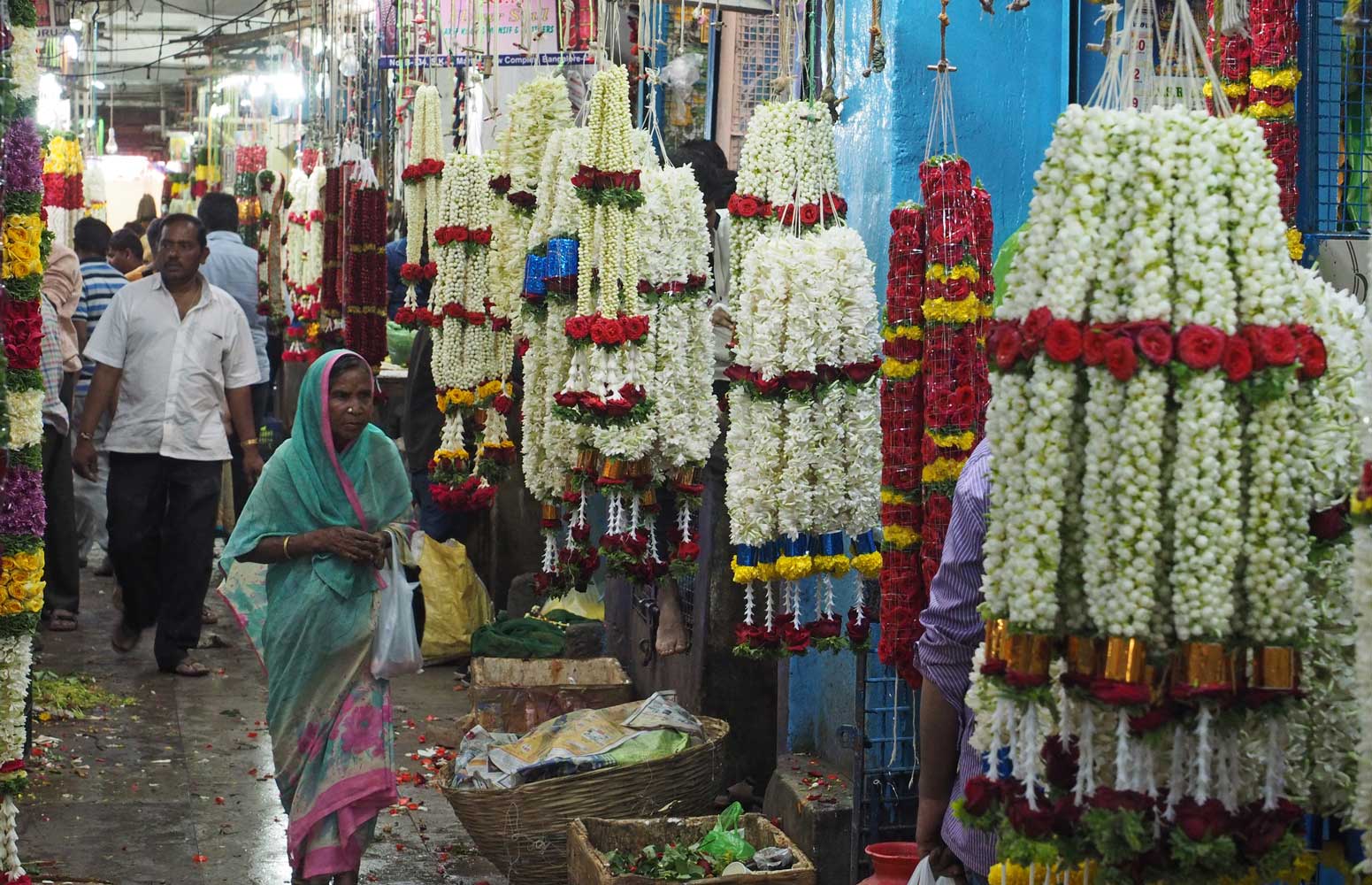
Sweet scents
Lastly I swung by the main city train station to see if I could get a ticket
to the Tamil Nadu temple town of Kanchipuram, but lines were very long and I found
that the main train line to Chennai bypasses Kanchipuram. So I decided to go by
bus, which a travel agent near the train station was able to sell.
27 December
Bengaluru
Today I headed for the National Gallery of Modern Art
http://ngmaindia.gov.in/ngma_bangaluru.asp
housed in an old mansion and in a new wing beside it. I especially enjoyed the temporary
retrospective exhibition ‘through the window’ by J S Khanderao (b. 1940), which
displayed fine portraits, landscapes, folk art, and abstract paintings. The regular
exhibits offered a great variety of Indian modern art, and I found them more appealing
than the selection at Karnataka Chitrakala Parisnath. Like that museum, however,
the NGMA prohibits photography inside!
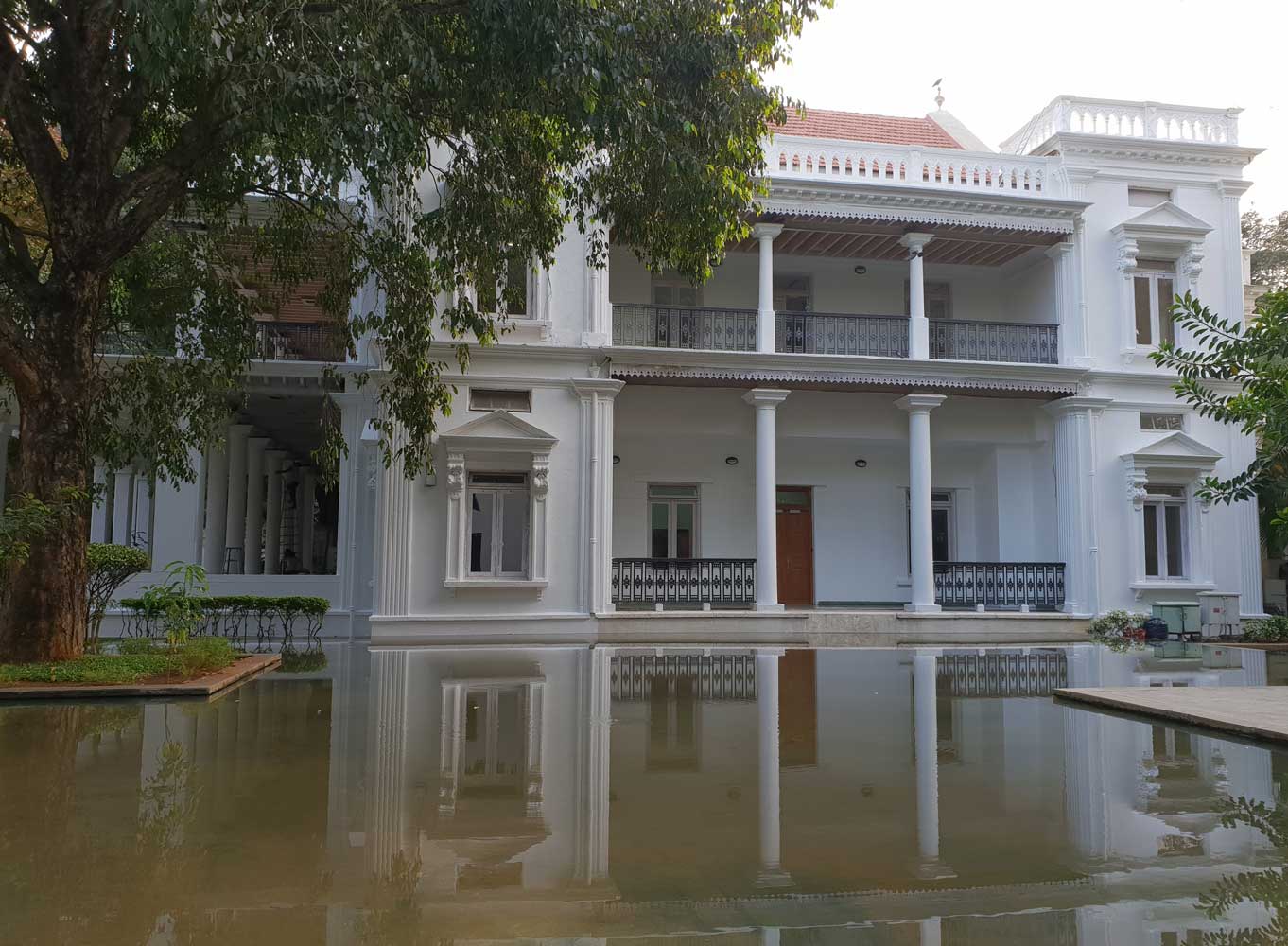
The old
mansion of the National Gallery of Modern Art holds many treasures.
28 December Bengaluru
I enjoy aviation, and the Indians does too! Hindustan
Aircraft Limited got its start in 1940 at Bangalore with the aim of manufacturing
aircraft in India. The company started building aircraft and engines under license,
then began designing and constructing its own planes and helicopters. HAL Heritage
Centre & Aerospace Museum
https://hal-india.co.in/Heritage%20Centre%20and%20Aerospace%20Museum/M__20 displays
many of those indigenous and license-built aircraft on the east side of the city.
They include a crop-duster, trainers, fighters, a bomber, and helicopters. A photo
exhibit illustrates the company’s history, and I was amused to find that both the
Dalai Lama and Richard Nixon had visited in the 1950s, presumably in separate parties.
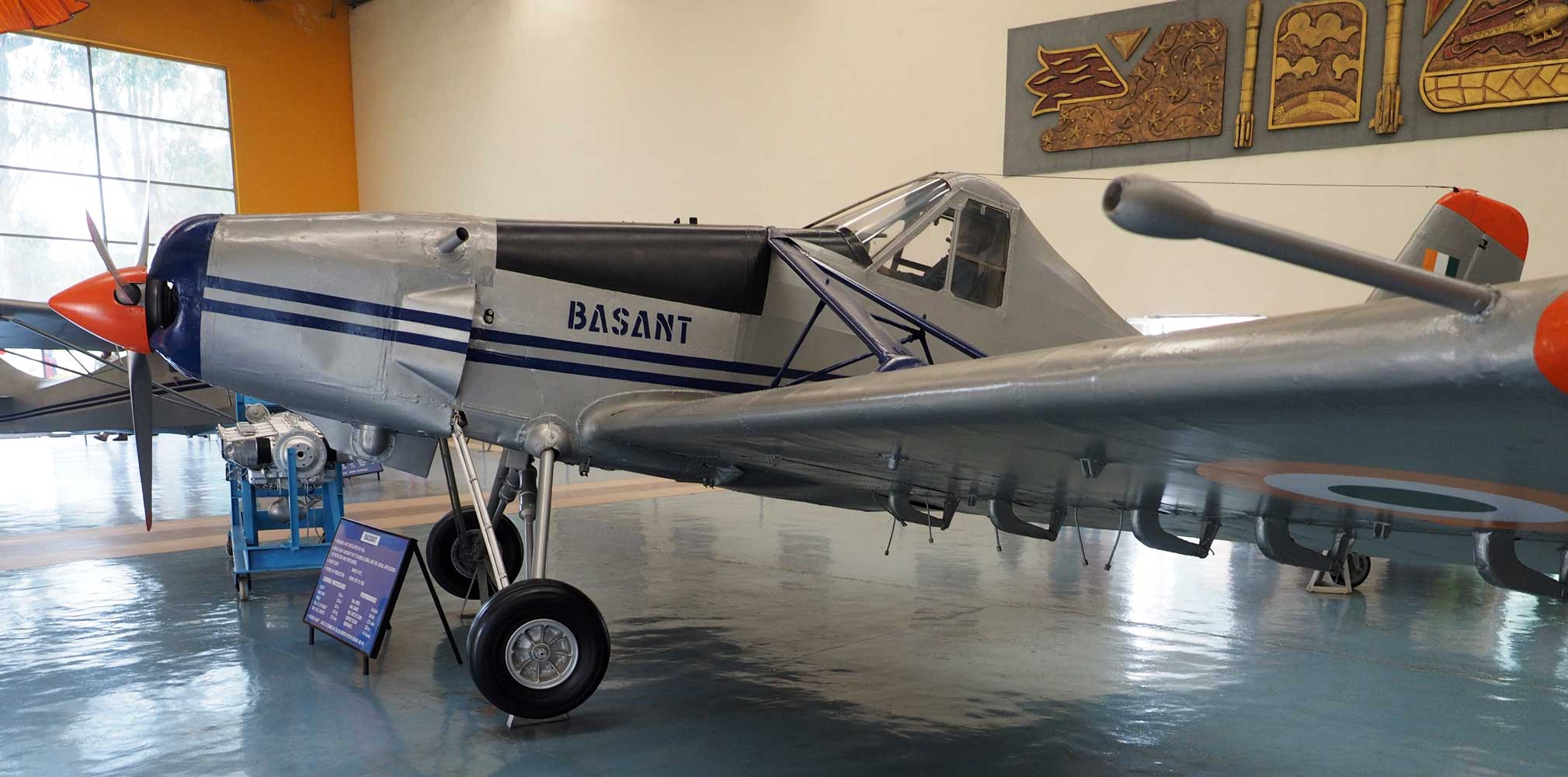
HAL designed the BASANT
for agricultural use to spread fertilizers and pesticides.
The plane made its
first flight in 1972 and was in production from 1976 to 1983.
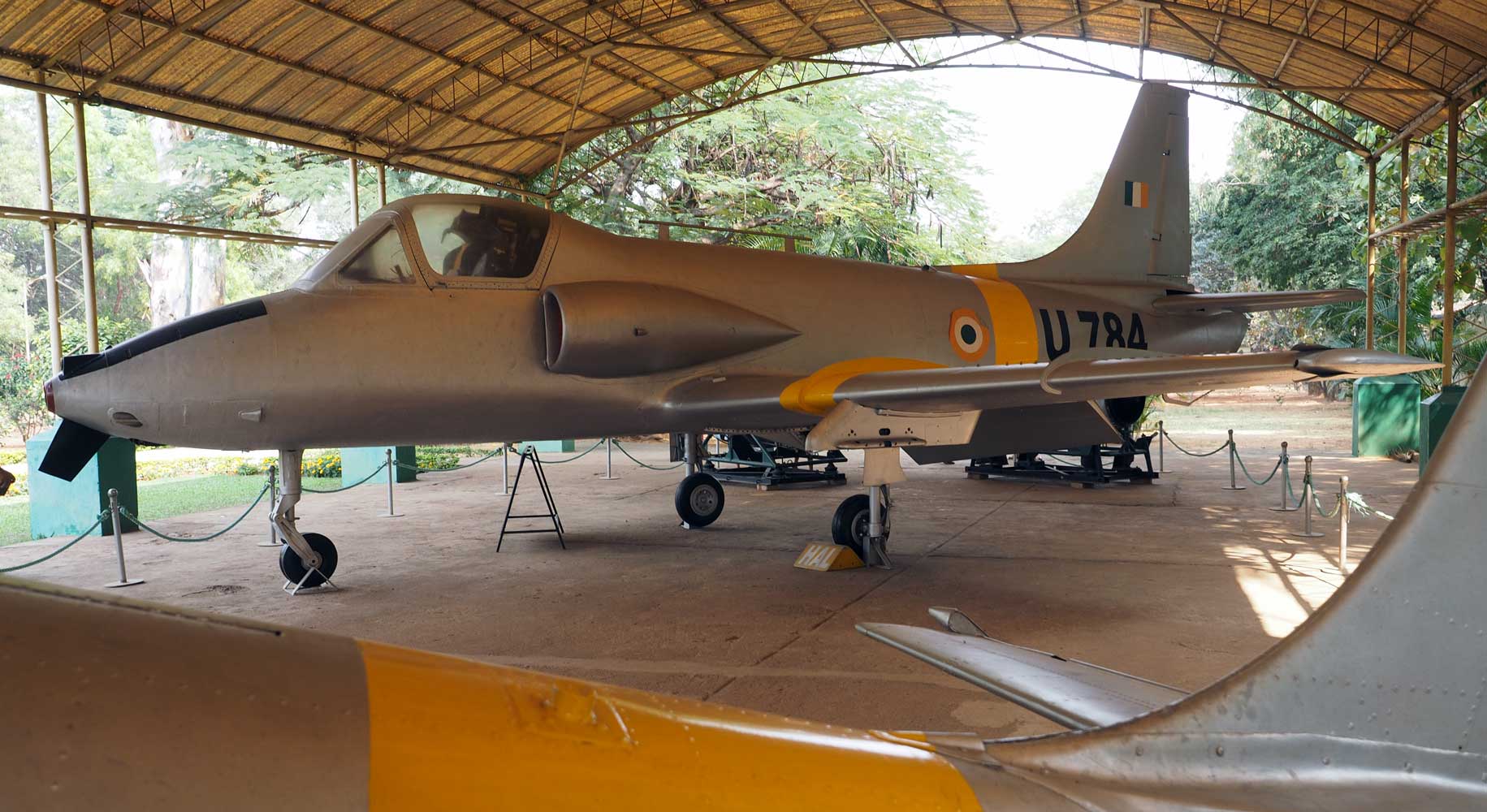
HAL developed the KIRAN
(“Ray of Light”) as a two-seater intermediate jet trainer.
The plane made its
first flight in 1964, went into production in 1967-82 (MK 1) and 1983-89 (MK 2)
and is still in service. Top speed is 715 km/hour (444 mph) for the MK 2.
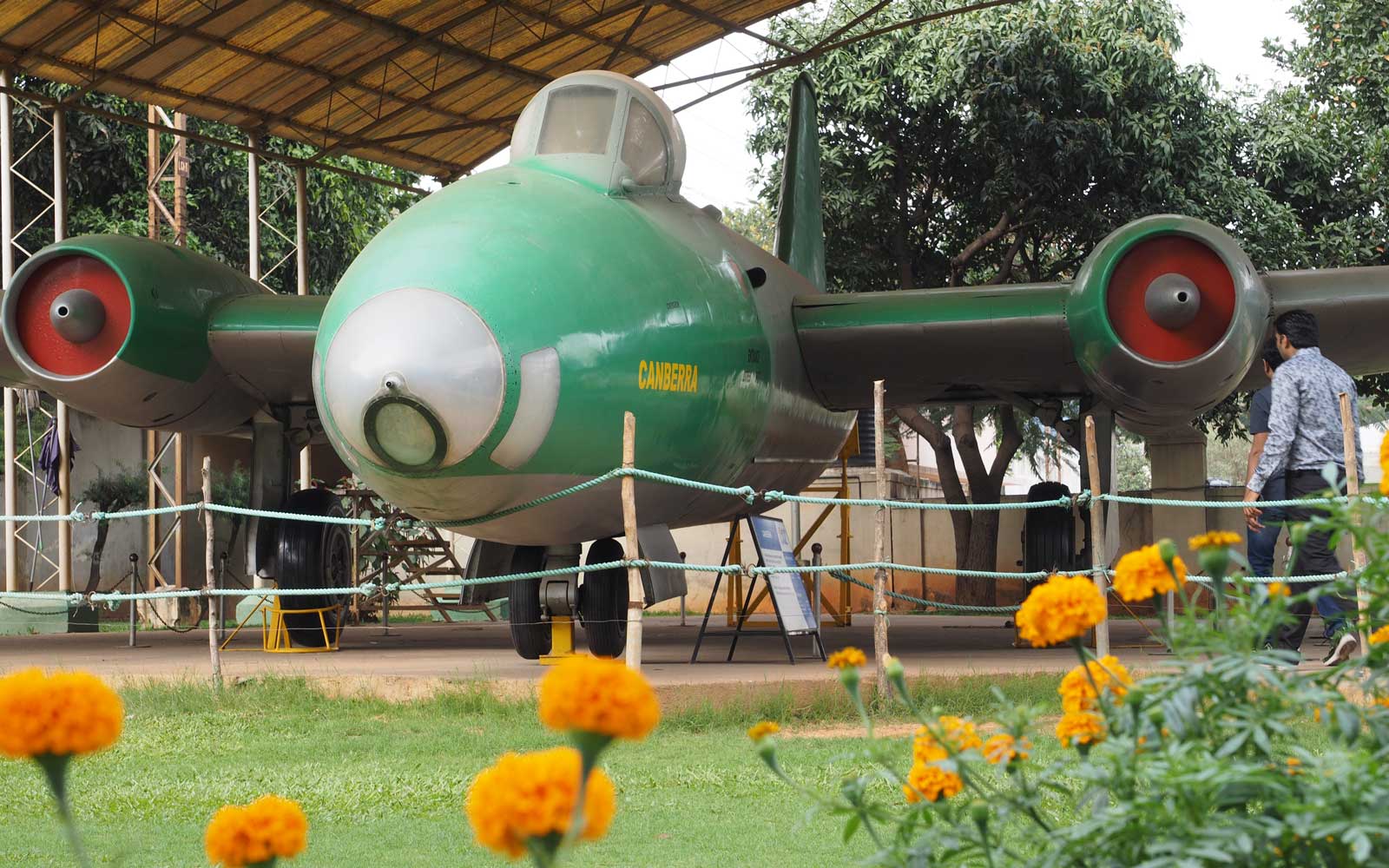
Many countries,
including India, built and used the highly successful CANBERRA, a bomber,
trainer,
and high-altitude photographic reconnaisance aircraft. It made its first flight
in 1949.
The offset canopy of this version allowed for an ejection seat of the
navigator, who sat in the nose.
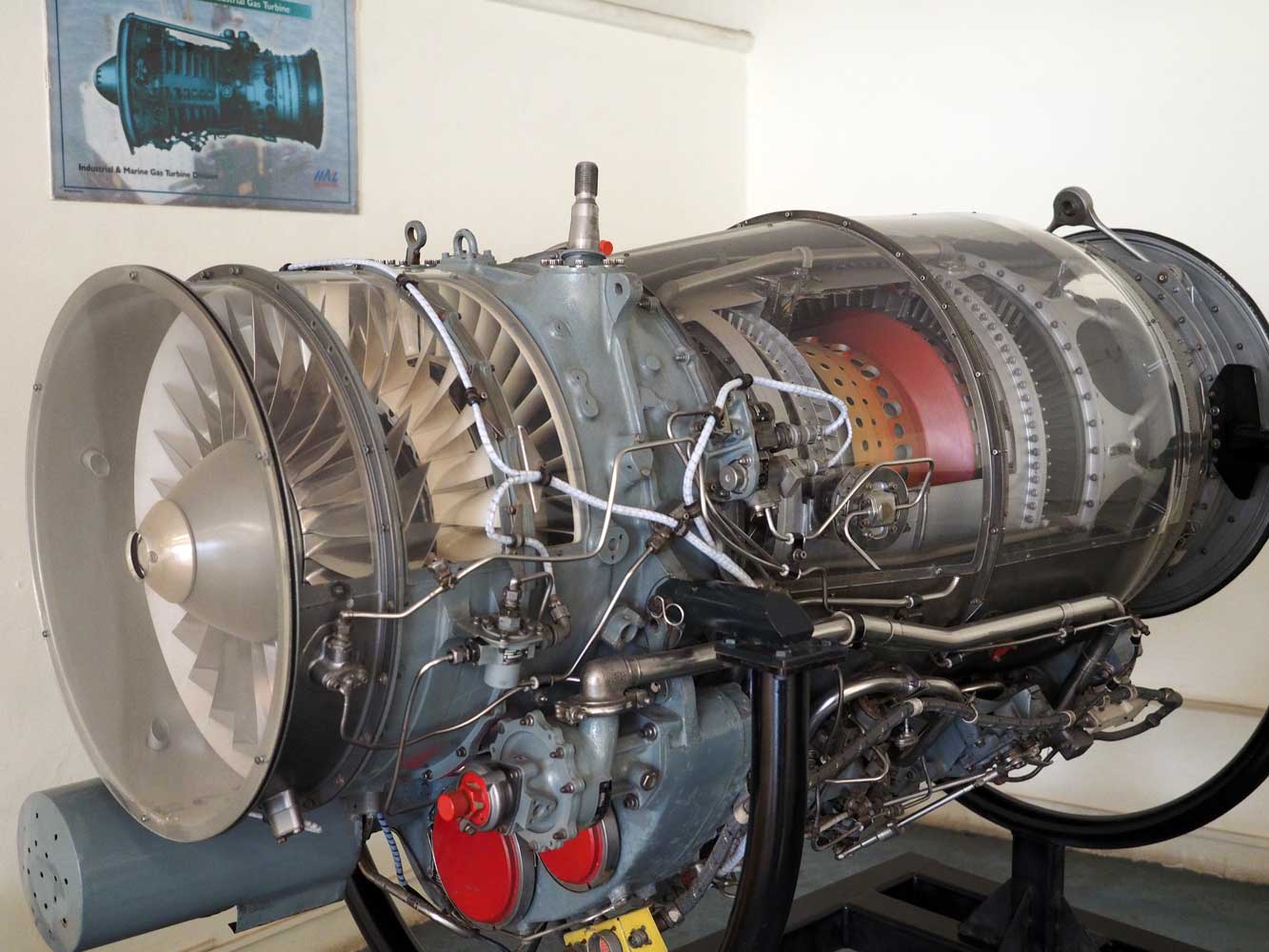
Adour MK 811 axial
flow turbo fan engine, designed by Rolls Royce, UK and Turbomeca, France.
Manufactured
and overhauled by HAL under license.
A long ride west in a three-wheeler brought me to Cubbon Park and a pair of museums, the 1877 red-brick Government Museum with mostly battered ancient stone sculpture on the ground floor and paintings upstairs, including some fine miniatures. Next door the Venkatappa Art Gallery featured beautiful landscapes by painter K. Venkatappa (1887-1962) and a very colorful temporary show by three artists. From there I walked through downtown to Brigade Road, lit up with colored lights for the New Year, where I had a fine palak paneer dinner at a fancy vegetarian restaurant, then dropped by a supermarket. My host had gotten a sim card for my phone, which can be difficult for foreigners to do in India, but it took nearly a day after activation for it to begin functioning.

Natyaganapathi, an
eight-armed Ganesh (11th C.) has his hands full! (Government Museum)

Kangra-style miniature
painting (Government Museum)
29 December Bengaluru
I worked much of the day sorting photos and posting
the best on Facebook. In the evening I headed back into the city center to hit an
ATM and to enjoy tasty South Indian food at a branch of the restaurant MTR 1924.
On to Tamil Nadu State: A Morning Among Temples in Kanchipuram